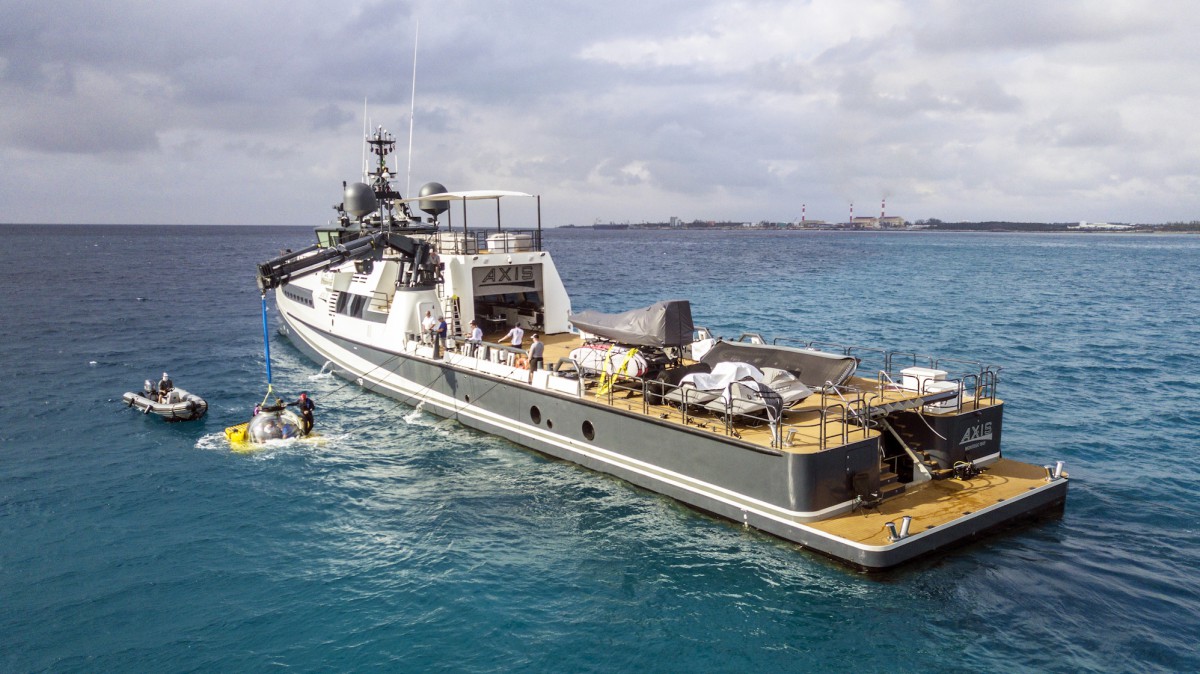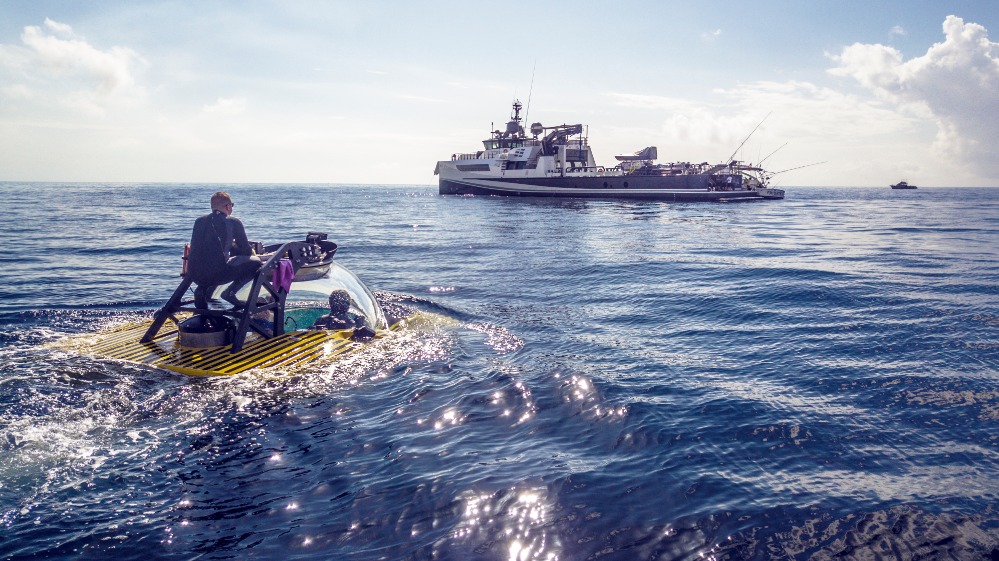Operating submersibles on board
Two superyacht captains discuss the impact these high-tech pieces of equipment have on operations…
For owners and charter guests seeking unique and adventurous experiences, having a submersible on board is very appealing. With some of the latest models on the market able to reach staggering depths, submersibles can dive into remote parts of the ocean and get up close and personal with marine life that was once inaccessible. The idea of having a submersible on board is no doubt also an exciting one for many captains and crew, but it does come with concerns about complex operations and maintenance procedures.
The submersible experience
On board the 55m Damen yacht support vessel Axis is a Triton 3300/3 submersible that can reach depths of 1,000 metres with two passengers and a pilot. Captain Les Annan says just going underwater in the submersible is an amazing first-time experience for most people. “Once you go below 35 metres [the safe scuba-diving limit], you are the first human to see whatever you see,” he adds. “Taking the sub to dive sites is very interesting as well as you can see so much aquatic life and geological sculptures. Being in the sub is more comfortable than scuba diving as you are dry and have communications [with the surface], with an enhanced peripheral view that you don’t get through a dive mask.”

Captain Jan Rautawaara has worked on superyachts for most of his career and has spent the past couple of years aboard the luxury cruise ship Crystal Esprit, which has a U-Boat Worx C-Explorer 3 submarine on board. He agrees that the submersible experience is unparalleled for guests. “From an experience point of view, it is unique and guests always find it very exciting,” says Rautawaara. “Guests will normally have high expectations about what they are going to see, but you never really know what you will find during a dive. To show them something special, it is best to dive deeper to depths of around 100 metres, where you can see things that can’t be seen [when] scuba diving.”
With regards to visibility and how much you are going to see, Annan says this can vary a lot, just like scuba diving, and depends to what depth you are diving. “At depths deeper than 250 metres, natural sunlight does not penetrate the water, so it’s pitch-black,” he says. “The submersible has strong lights so that you can see for a distance of about 20 metres depending on the visibility. The lights highlight all the colours so it is very magical and colourful down there. When you go deeper than 500 metres, the sea life is even more interesting and different from what you find in shallow water. It truly is an outer worldly experience.”
Destinations and permission
The main challenge with submersible operations comes down to stringent local laws in certain destinations. “If you want to use the submersible, you have to have a permit from the local authorities to dive and some countries can be very strict due to a lack of awareness of what a submersible actually is,” advises Rautawaara. “Even though scuba-diving companies can go pretty much anywhere, the authorities sometimes only give an assigned area in which the submersible can be used and often these sites don’t show much of interest. For example, we couldn’t get a permit in Greece and only managed to get permits for three sites in Croatia. In the Caribbean, we couldn’t get a permit for the British Virgin Islands; however, we did for Saba, St Barths and St Kitts and Nevis.”
In Annan’s experience, while not all countries will allow yachts to just show up with a submersible and dive, working with a local agent and allowing some preparation time will usually result in permission being granted. One particular aspiration for him is to go with Axis to Truk Lagoon in Micronesia where there are many untouched Japanese wrecks from the Second World War that are too deep for scuba diving.
Set-up and launch considerations
“While not necessary, the ideal set-up would be a hanger or garage for the submersible so that it can be kept inside when not in use, protected from the elements and [where it is] easy to maintain,” says Rautawaara. “A crane capable of lifting the sub into the water by the vessel’s side is also needed. Once the submersible is in the water, the pilot enters from a tender, the submersible is disconnected from the mother ship, guests are brought on board and the dive can begin. We usually operate close to the mother ship, no more than a mile away. Furthermore, the submersible pilot is also in constant communication via an underwater radio transmitter, with our tender acting as the surface safety guard boat. Safety is obviously the highest priority at all times and even the passengers get a thorough safety briefing before going on board the sub.”
On board Axis, submersible launches can be made over a sea wall. “This means when we are in deep water, we can use the Damen dynamic positioning on board to allow us to hold position after the launch of the submarine directly over the desired area of interest with no commute from shallower anchorages, allowing more ‘action time’ on the dive,” explains Annan. While Axis does not have an A-frame and gets along fine without it, Annan recommends it for a boat going around the world because it allows the launch and recovery of the submersible in higher seas.

“We are very lucky to have such a capable boat as the Damen yacht-support vessel to work from and great owners [who] give us all the tools we need to make it enjoyable for them and their guests,” continues Annan. “Damen has an amazing worldwide support system for the yacht, so going anywhere in the world is not a worry on Axis. Damen fitted us with a 19,000-kilo crane that easily picks up the 8,000-kilo submersible and all of the other toys on deck. An average dive lasts two to three hours and reaches depths of 200 to 300 metres. Before a dive begins, a short Triton safety video is played, just like on an airplane, and the pilot gives the passengers a short briefing before going down.”
Operations
There is some misunderstanding that submersibles are complex pieces of equipment to set up. For the submersible on board Axis, the sub pilot needs to be certified by Triton Submarines and approved by the insurance company or Triton will supply a sub pilot when needed anywhere in the world. “I went to its school for two weeks and then did over 20 dives with an instructor and [had] a verbal test from a group of instructors,” says Annan. “In my case it was easy to learn as I am a master scuba-diving instructor with over 6,000 dives. I also do all the service on the sub as well as I have a Y1 engineer ticket and the sub is very easy to work on and maintain. I can now train new pilots and when I think they are ready Triton can come out and test them.”
Rautawaara is also trained as a pilot for the U-Boat Worx submersible on board Crystal Esprit. “The pilot licence consists of about three weeks of training and teaches you about all the systems on your specific model of submersible,” he explains. “You then have to pass a theory and practical assessment which goes through all emergency scenarios. With regards to maintenance, there is not much that the yacht’s crew are able to do as the manufacturer has a very good system and logging process to keep on top of the maintenance requirements. For any technical issues, they will send one of their own technicians to the vessel. In addition, our submersible is also inspected annually by a classification society just like any other vessel.”
The crew on board Axis are all well trained in lifting heavy items on deck and in surface operations for the submersible as well. Whenever the submersible is in use, a tender is shadowing it on the surface, supplying a GPS signal and communications with the sub which orally checks in every 15 minutes to ensure communication at all times.
The submersible market has been stigmatised to some extent in the superyacht industry because of unfounded concerns about complex and dangerous operations. However, the industry is coming to realise just how amazing the submersible experience can be, as described by the captains above, as well as just how straightforward the operational aspect actually is.
Images courtesy of Allen Exploration and Triton Submarines
Profile links
NEW: Sign up for SuperyachtNewsweek!
Get the latest weekly news, in-depth reports, intelligence, and strategic insights, delivered directly from The Superyacht Group's editors and market analysts.
Stay at the forefront of the superyacht industry with SuperyachtNewsweek
Click here to become part of The Superyacht Group community, and join us in our mission to make this industry accessible to all, and prosperous for the long-term. We are offering access to the superyacht industry’s most comprehensive and longstanding archive of business-critical information, as well as a comprehensive, real-time superyacht fleet database, for just £10 per month, because we are One Industry with One Mission. Sign up here.
NEW: Sign up for
SuperyachtNewsweek!
Get the latest weekly news, in-depth reports, intelligence, and strategic insights, delivered directly from The Superyacht Group's editors and market analysts.
Stay at the forefront of the superyacht industry with SuperyachtNewsweek




